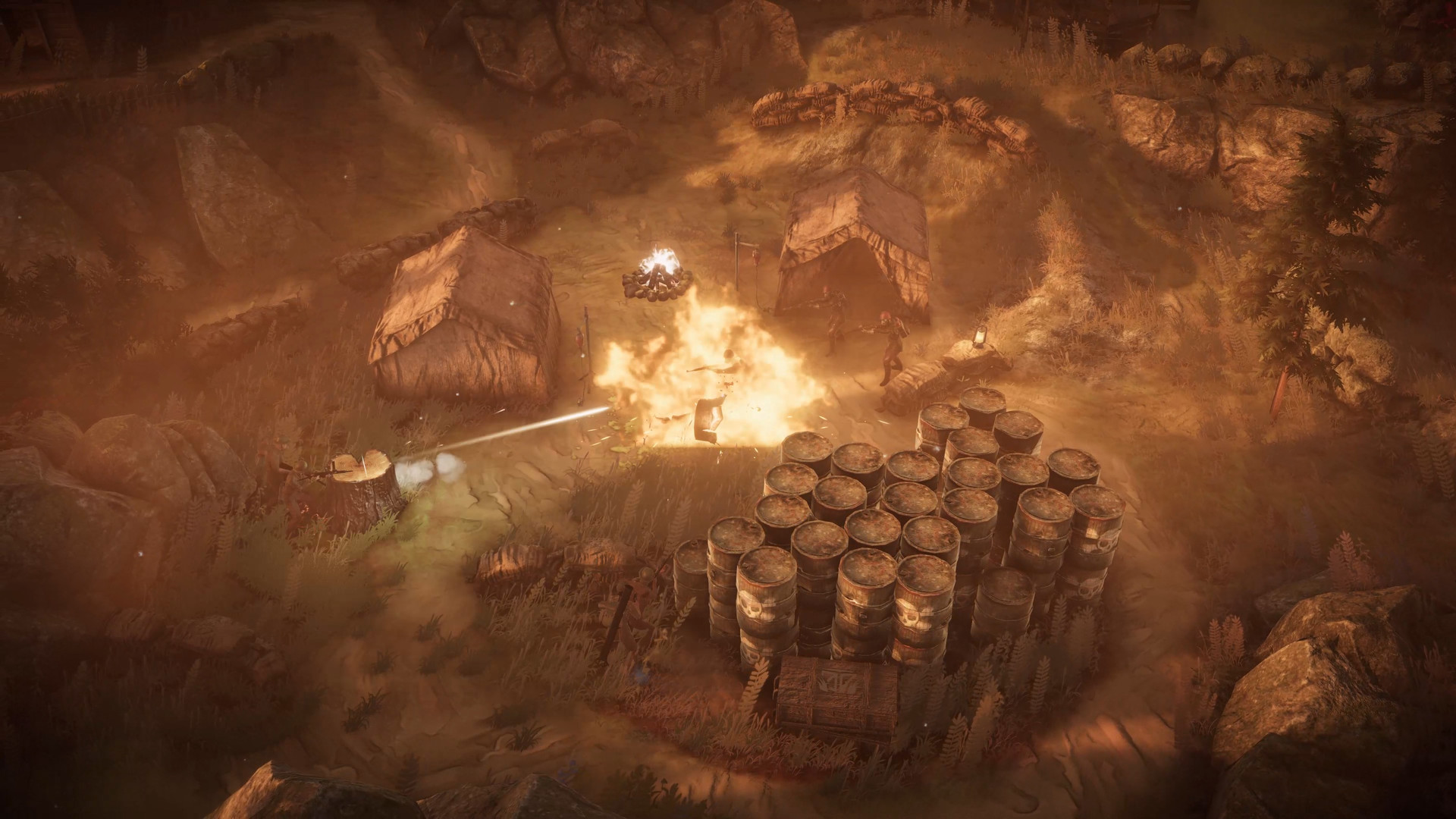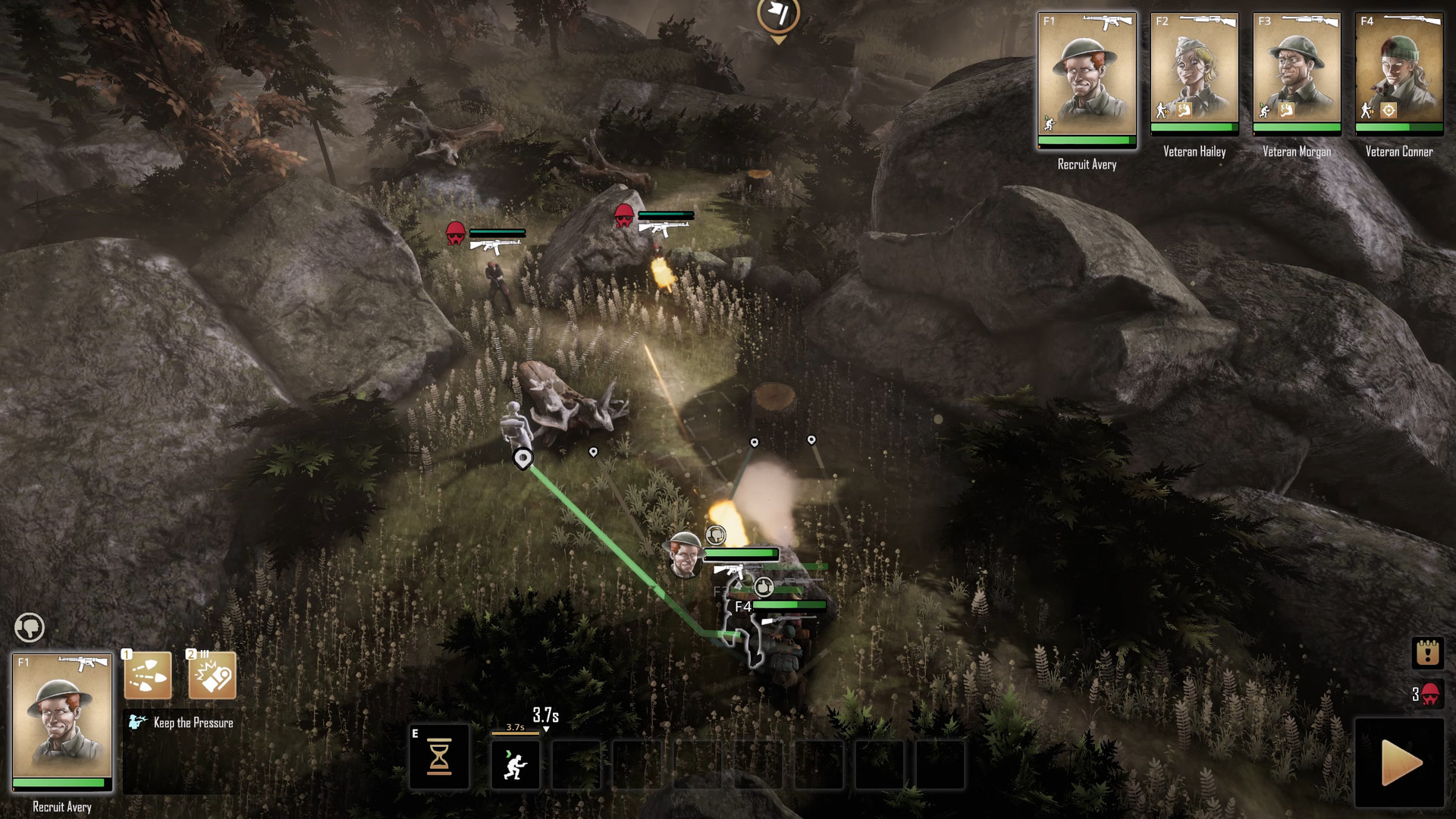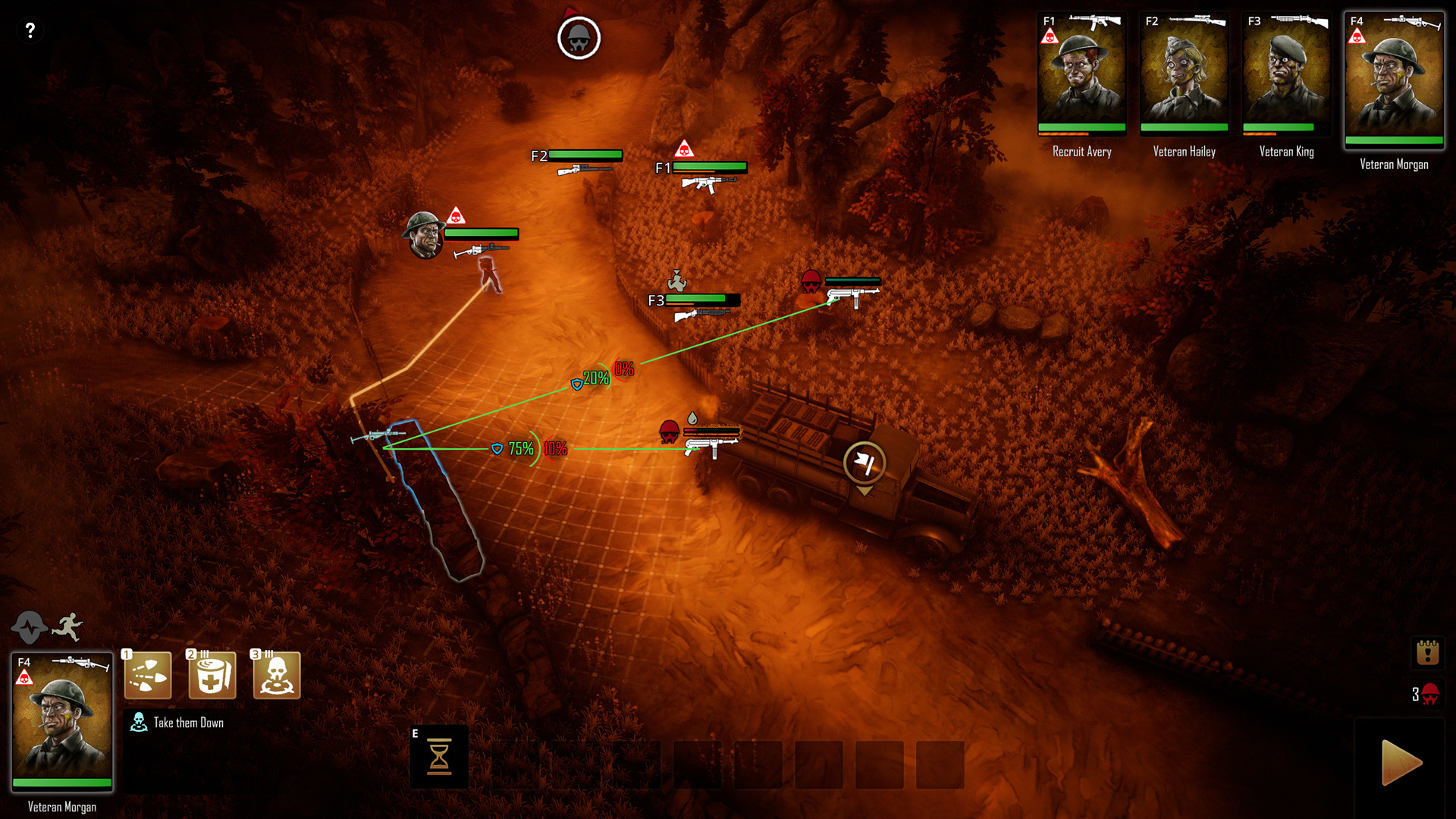- Joined
- Jan 28, 2011
- Messages
- 99,592















Tags: Broken Lines; PortaPlay
The Codex front page can be a pretty weird place. Sometimes there's a game that everybody has played but nobody feels like reviewing (*cough cough* Pathfinder: Kingmaker). Other times, you might have a game that one guy played and found really interesting. Broken Lines is that kind of game - a WW2-themed tactical RPG with Frozen Synapse-style simultaneous turn-based combat, which is something I've personally been wanting to see more of for years. In his comprehensive review, the esteemed Strange Fellow finds Broken Lines to be a fun but somewhat lightweight experience. Here's an excerpt:
One perhaps controversial point that I want to make at this point has to do with the move away from simulationist design which has become fairly common in modern squad tactics, arguably heralded by the rebooted XCOM series. In a nutshell, games that do this will often treat guns, auxiliary items and physical abilities more like D&D spells than their real-life counterparts. This annoys me to no end when it's applied to games with more "realistic" backdrops, because in addition to throwing believability out the window, it also tends to hamper creative play across the board. Gone are the days of tossing a backup weapon from soldier to soldier when your front man’s gun jams in a tight spot, or rushing over to a fallen enemy to pick up the grenade he dropped – sacrificed for the commodification of tactical manoeuvres.
So where does Broken Lines fall on this scale? The answer is somewhere in the middle. Like Firaxis XCOM, grenades and healing items are not singular objects, but abilities of sorts, which are assigned to your units at the start of a mission and which have a set number of uses, replenish for each battle, and cannot be redistributed or dropped in the field. What’s more disappointing is that there is also no looting of any kind, apart from the aforementioned supply caches. Enemies will not drop their items, and you will find no stashes of weapons or auxiliaries in the maps themselves. The only way to gain new stuff is to buy it from the merchant. Your own weapons can’t be dropped or swapped mid-mission either, and all guns have unlimited ammo.
None of this gels at all with the premise of the story nor with the gameplay itself. You’re supposed to be commandeering a small group of soldiers stranded behind enemy lines, scrounging for survival, yet the resource management, which should have been a major concern, is practically non-existent. At no point will you have to think carefully about rationing supplies in the field (by which I mean actual supplies like grenades or healing items, not food), because they don’t really exist, and there are no overarching worries beyond making sure your soldiers don’t die. The best games manage to weave long-term strategic considerations into the moment-to-moment tactical decision-making; Broken Lines, despite the overall structure providing a perfect slate, doesn’t even try.
The actual combat mechanics fare a lot better in this regard, though they haven’t been spared completely. For one, bullets that miss their target will disappear into the ether when the maximum range of the weapon that fired it is reached. Then there are some downright silly abilities, like “Drunken”, which boosts courage at the expense of accuracy for a short while (to top it off, this is also completely useless).
However, there are a couple of cool systems that make up for it. First is the fact that bullets in Broken Lines are real game objects, which means that each one will travel until it hits something (or gets swallowed by the god of Balance if it travels too far), whether that something is an enemy, an ally, or a piece of scenery. This is good because it makes cover work like it should, which is by actually blocking the path of incoming fire rather than just conveying a flat reduction to enemy accuracy.
Another advantage of this is that it feeds into another cool system, which is stress. The stress mechanic is central to the combat of Broken Lines, and it works like this: in addition to HP, each soldier has a stress bar which fills up when bullets pass near them. When it reaches a threshold, the soldier will panic for a few seconds. A panicking soldier will look for an escape route, and if he finds one he’ll run for it, but most of the time he’ll just cower in place. You won’t be able to issue orders to a panicking soldier until he calms down.
Stressing out your enemies is essential to taking them down, which means that automatic weapons are going to be your new best friends. All weapons in this category fall under the "SMG" type, and in addition to the high rate of fire, they have another trick up their sleeve that make their suppressive capabilities even more powerful. Each weapon type in the game, in addition to its native properties, has a distinct special firing mode, and the special firing mode of the SMG consists simply of rattling off at full blast blanketing a specified area with heavy fire. It’s inaccurate, but guaranteed to cause any enemies within it to panic, and you can direct it at will rather than just have it target the closest enemy. This means that the primary usage of the SMG is to pin down enemies in cover and cut off any escape routes, while the rest of the squad moves in and takes them down from the flanks. This can be combined with camouflage from thick vegetation, as well as elevation bonuses, for some properly devastating manoeuvres. It's nice to see that after years of games that either ignore the potential of this mechanic or else half-ass the implementation, a game has finally been made that gets cover fire right.
So how do missions actually play out? Well, most of the time you’ll pick out a route at the beginning that takes you to the finish point, ideally via any supply caches that may be present, and then advance along it, engaging in the suppress-and-flank dance whenever you encounter groups of hostiles. That’s pretty much it.
And you know what? It’s a lot of fun. There are a few key things that make it work. First of all, there’s the fact that the onus is generally on you to advance while enemies wait for you to approach, meaning that there’s almost never an occasion to pull out the old “line up the firing squad and wait for the enemy to file into a bottleneck like lemmings” trick. The score system also helps here, since if you want to get a perfect score you can’t dawdle. This is thrown into relief during the few missions where you’re tasked with defending yourself against an enemy counterattack or ambush, at which point the game turns into a tower defence of sorts, which isn't nearly as much fun.
Moreover, battles also encourage you to stay mobile as much as possible. A lot of cover is destructible and will be decimated by machine gun volleys within a single turn, and grenades and heavier artillery, should the enemy have it, will wreck your soldiers no matter what sort of cover they're hiding behind, not to mention that enemy soldiers aren’t afraid to move to better positions if you let them.
This all combines to make battles very dynamic affairs. I’ve thought about why I’ve had more fun with this game than it feels like I should, given how basic it is. It boils down, I think, to the simple recipe of a few interlocking systems pulling in the same direction. The game wants to constantly keep you moving and moving around and behind enemies, and every facet of gameplay serves to reinforce this idea. It does this with very little variation throughout, since you'll mostly be fighting the same enemies from beginning to end, and you'll have access to all the weapon types from the get-go. And yet it works. If I might make another return to my XCOM vendetta, there’s a marked contrast here in that the tactical layer of Broken Lines seems to encourage you to explore its workings and get familiar with it, instead of covering a pedestrian foundation with an ever-increasing load of fancy toys.
Read the full article: RPG Codex Review: Broken Lines
The Codex front page can be a pretty weird place. Sometimes there's a game that everybody has played but nobody feels like reviewing (*cough cough* Pathfinder: Kingmaker). Other times, you might have a game that one guy played and found really interesting. Broken Lines is that kind of game - a WW2-themed tactical RPG with Frozen Synapse-style simultaneous turn-based combat, which is something I've personally been wanting to see more of for years. In his comprehensive review, the esteemed Strange Fellow finds Broken Lines to be a fun but somewhat lightweight experience. Here's an excerpt:
One perhaps controversial point that I want to make at this point has to do with the move away from simulationist design which has become fairly common in modern squad tactics, arguably heralded by the rebooted XCOM series. In a nutshell, games that do this will often treat guns, auxiliary items and physical abilities more like D&D spells than their real-life counterparts. This annoys me to no end when it's applied to games with more "realistic" backdrops, because in addition to throwing believability out the window, it also tends to hamper creative play across the board. Gone are the days of tossing a backup weapon from soldier to soldier when your front man’s gun jams in a tight spot, or rushing over to a fallen enemy to pick up the grenade he dropped – sacrificed for the commodification of tactical manoeuvres.
So where does Broken Lines fall on this scale? The answer is somewhere in the middle. Like Firaxis XCOM, grenades and healing items are not singular objects, but abilities of sorts, which are assigned to your units at the start of a mission and which have a set number of uses, replenish for each battle, and cannot be redistributed or dropped in the field. What’s more disappointing is that there is also no looting of any kind, apart from the aforementioned supply caches. Enemies will not drop their items, and you will find no stashes of weapons or auxiliaries in the maps themselves. The only way to gain new stuff is to buy it from the merchant. Your own weapons can’t be dropped or swapped mid-mission either, and all guns have unlimited ammo.
None of this gels at all with the premise of the story nor with the gameplay itself. You’re supposed to be commandeering a small group of soldiers stranded behind enemy lines, scrounging for survival, yet the resource management, which should have been a major concern, is practically non-existent. At no point will you have to think carefully about rationing supplies in the field (by which I mean actual supplies like grenades or healing items, not food), because they don’t really exist, and there are no overarching worries beyond making sure your soldiers don’t die. The best games manage to weave long-term strategic considerations into the moment-to-moment tactical decision-making; Broken Lines, despite the overall structure providing a perfect slate, doesn’t even try.
The actual combat mechanics fare a lot better in this regard, though they haven’t been spared completely. For one, bullets that miss their target will disappear into the ether when the maximum range of the weapon that fired it is reached. Then there are some downright silly abilities, like “Drunken”, which boosts courage at the expense of accuracy for a short while (to top it off, this is also completely useless).
However, there are a couple of cool systems that make up for it. First is the fact that bullets in Broken Lines are real game objects, which means that each one will travel until it hits something (or gets swallowed by the god of Balance if it travels too far), whether that something is an enemy, an ally, or a piece of scenery. This is good because it makes cover work like it should, which is by actually blocking the path of incoming fire rather than just conveying a flat reduction to enemy accuracy.
Another advantage of this is that it feeds into another cool system, which is stress. The stress mechanic is central to the combat of Broken Lines, and it works like this: in addition to HP, each soldier has a stress bar which fills up when bullets pass near them. When it reaches a threshold, the soldier will panic for a few seconds. A panicking soldier will look for an escape route, and if he finds one he’ll run for it, but most of the time he’ll just cower in place. You won’t be able to issue orders to a panicking soldier until he calms down.
Stressing out your enemies is essential to taking them down, which means that automatic weapons are going to be your new best friends. All weapons in this category fall under the "SMG" type, and in addition to the high rate of fire, they have another trick up their sleeve that make their suppressive capabilities even more powerful. Each weapon type in the game, in addition to its native properties, has a distinct special firing mode, and the special firing mode of the SMG consists simply of rattling off at full blast blanketing a specified area with heavy fire. It’s inaccurate, but guaranteed to cause any enemies within it to panic, and you can direct it at will rather than just have it target the closest enemy. This means that the primary usage of the SMG is to pin down enemies in cover and cut off any escape routes, while the rest of the squad moves in and takes them down from the flanks. This can be combined with camouflage from thick vegetation, as well as elevation bonuses, for some properly devastating manoeuvres. It's nice to see that after years of games that either ignore the potential of this mechanic or else half-ass the implementation, a game has finally been made that gets cover fire right.
So how do missions actually play out? Well, most of the time you’ll pick out a route at the beginning that takes you to the finish point, ideally via any supply caches that may be present, and then advance along it, engaging in the suppress-and-flank dance whenever you encounter groups of hostiles. That’s pretty much it.
And you know what? It’s a lot of fun. There are a few key things that make it work. First of all, there’s the fact that the onus is generally on you to advance while enemies wait for you to approach, meaning that there’s almost never an occasion to pull out the old “line up the firing squad and wait for the enemy to file into a bottleneck like lemmings” trick. The score system also helps here, since if you want to get a perfect score you can’t dawdle. This is thrown into relief during the few missions where you’re tasked with defending yourself against an enemy counterattack or ambush, at which point the game turns into a tower defence of sorts, which isn't nearly as much fun.
Moreover, battles also encourage you to stay mobile as much as possible. A lot of cover is destructible and will be decimated by machine gun volleys within a single turn, and grenades and heavier artillery, should the enemy have it, will wreck your soldiers no matter what sort of cover they're hiding behind, not to mention that enemy soldiers aren’t afraid to move to better positions if you let them.
This all combines to make battles very dynamic affairs. I’ve thought about why I’ve had more fun with this game than it feels like I should, given how basic it is. It boils down, I think, to the simple recipe of a few interlocking systems pulling in the same direction. The game wants to constantly keep you moving and moving around and behind enemies, and every facet of gameplay serves to reinforce this idea. It does this with very little variation throughout, since you'll mostly be fighting the same enemies from beginning to end, and you'll have access to all the weapon types from the get-go. And yet it works. If I might make another return to my XCOM vendetta, there’s a marked contrast here in that the tactical layer of Broken Lines seems to encourage you to explore its workings and get familiar with it, instead of covering a pedestrian foundation with an ever-increasing load of fancy toys.





















![Glory to Codexia! [2012] Codex 2012](/forums/smiles/campaign_tags/campaign_slushfund2012.png)
![Have Many Potato [2013] Codex 2013](/forums/smiles/campaign_tags/campaign_potato2013.png)
![The Year of Incline [2014] Codex 2014](/forums/smiles/campaign_tags/campaign_incline2014.png)







